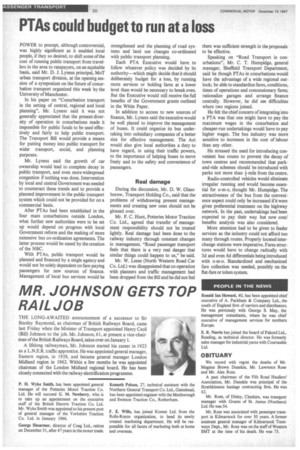PTAs could budget to run at a loss
Page 32

If you've noticed an error in this article please click here to report it so we can fix it.
POWER to precept, although controversial, was highly significant as it enabled local people, if they so desired, to shift some of the cost of running public transport from travellers in the area to ratepayers, on an equitable basis, said Mr. D. J. Lyness principal, MoT urban transport division, at the opening session of a symposium on the future of conurbation transport organized this week by the University of Manchester.
In his paper on "Conurbation transport in the setting of central, regional and local planning", Mr. Lyness said it was not generally appreciated that the present diversity of operation in conurbations made it impossible for public funds to be used effectively and fairly to help public transport. The Transport Bill would provide a means for putting money into public transport for wider transport, social, and planning purposes.
Mr. Lyness said the growth of car ownership would lead to complete decay in public transport, and even more widespread congestion if nothing was done. Intervention by local and central Government was needed to counteract these trends and to provide a planned improvement in the public transport system which could not be provided for on a commercial basis.
After PTAs had been established in the four main conurbations outside London, what further new authorities were to be set up would depend on progress with local Government reform and the making of more extensive bus co-ordination agreements. The latter process would be eased by the creation of the NBC.
With PTAs, public transport would be planned and financed by a single agency and would not be solely dependent on fare-paying passengers for new sources of finance. Management of local bus services would be strengthened and the planning of road systems and land use changes co-ordinated with public transport planning.
Each PTA Executive would have, to follow whatever policy was decided by its authority—which might decide that it should deliberately budget for a loss, by running more services or holding fares at a lower level than would be necessary to break even. But the Executive would still receive the full benefits of the Government grants outlined in the White Paper.
In addition to access to new sources of finance, Mr. Lyness said the executive would be well placed to improve the management of buses. It could organize its bus undertaking into subsidiary companies of a better size for effective management. The Act would also give local authorities a duty to have regard, in using their traffic powers, to the importance of helping buses to move freely and to the safety and convenience of passengers.
Real damage
During the discussion, Mr. D. W. Glassborow, Transport Holding Co., said that the problems of withdrawing present managements and creating new ones should not be glossed over.
Mr. P. C. Hunt, Potteries Motor Traction Co. Ltd., agreed that transfer of management responsibility should not be treated lightly. Real damage had been done to the railway industry through constant changes in management. "Road passenger transport feels that there is a very real danger that similar things could happen to us," he said.
Mr. W. Leese (North Western Road Car Co. Ltd.) was disappointed that co-operation with planners and traffic management had been dropped from the Bill and he did not feel there was sufficient strength in the proposals to be effective.
Speaking on "Road Transport in conurbations", Mr. C. T. Humpidge, general manager, Sheffield Transport Department, said he though PTAs in conurbations would have the advantage of a wide regional outlook; be able to standardize fares, conditions, times of operations and concessionary fares; rationalize garages and arrange finance centrally. However, he did see difficulties where two regions joined.
He felt the chief concern of integrating into a PTA was that one might have to pay the maximum wages in the conurbation and cheaper-run undertakings would have to pay higher wages. The bus industry was more sensitive to increases in the cost of labour than any other.
He stressed the need for introducing convenient bus routes to prevent the decay of town centres and recommended that parkand-ride schemes should be introduced with parks not more than 4-mile from the centre.
Radio-controlled vehicles would eliminate irregular running and would become essential for o-m-o, thought Mr. Humpidge. The attractiveness of the bus from the convenience aspect could only be increased if it were given preferential treatment on the highway network. In the past, undertakings had been expected to pay their way but now cost/ benefits analysis was also considered.
More attention had to be given to feeder services as the industry could not afford too many through routes. Properly located interchange stations were imperative. Fares structures would have to change radically with 3d and even 6d differentials being introduced with o-m-o. Standardized and mechanized fare collection was needed, possibly on the flat-fare or token system.












































































































